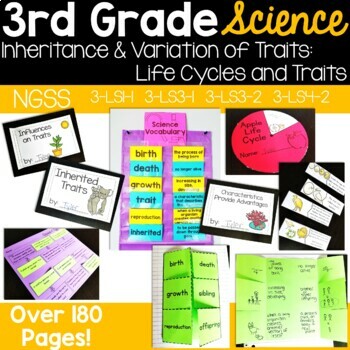3rd Grade Inherited Traits Worksheets Plant & Animal Life Cycle Activities NGSS
- PDF
What educators are saying
Also included in
- Are you struggling to find engaging science materials for your third grade NGSS lessons? These science units include so many activities and resources that you can use! There are mini books, vocabulary, posters, hands-on activities, passages, and so much more! This is a bundle of my four 3rd Grade NGPrice $38.00Original Price $56.00Save $18.00
Description
Are you looking for a fun way to teach 3rd grade inherited traits and life cycles? In this third grade science unit students will learn about plant and animal life cycles and how they have similar stages, inherited traits of plants, animals, and people, plus how the environment can influence traits. This third grade science unit has everything you need to engage your students and learn! There are many high interest activities that your students will love!
This third grade unit on inherited traits and life cycles aligns to NGSS* standards 3-LS1-1, 3-LS3-1, 3-LS3-2, 3-LS4-2 and many other state standards.
This unit includes so many activities and resources that you can use! There are mini books, vocabulary, posters, hands on activities, non-fiction passages, worksheets and so much more!
It covers four topics:
- Plant and Animal Life Cycles
- Inherited Traits
- Environmental Influences on Traits
- Advantages for Survival
Download the 45 page preview to see what's included in this 180 page resource!
TEACHERS LIKE YOU SAID...
⭐⭐⭐⭐⭐This was a wonderful resource. I do not usually like to spend more than $10, but this was well well worth it!! You will not regret the amount of information that is provided in this resource!!!
⭐⭐⭐⭐⭐My students loved this unit! Everything was explained well for the teacher and the students really enjoyed the discussions that came up throughout their learning.
⭐⭐⭐⭐⭐This resource was great to teach inherited and acquired traits. Students enjoyed it a lot! There are a lot of activities in this bundle :)
⭐Save the most by purchasing the 3rd Grade Science BUNDLE! ⭐
It includes this unit and the following other units:
- 3rd Grade Forces & Interactions
- 3rd Grade Weather & Climate
- 3rd Grade Interdependent Relationships in Ecosystems
*NGSS and Next Generation Science Standards are a registered trademark of Achieve. Neither Achieve nor the lead states and partners that developed the Next Generation Science Standards was involved in the production of, and does not endorse, this product.
©Thrifty in Third Grade
ALL RIGHTS RESERVED






